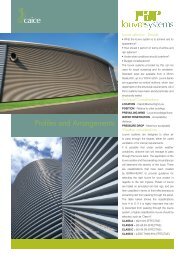CAICE Attenuator
CAICE Attenuator
CAICE Attenuator
Create successful ePaper yourself
Turn your PDF publications into a flip-book with our unique Google optimized e-Paper software.
<strong>Attenuator</strong> Performance<br />
What we do know is that ISO 7235 has gone to extraordinary<br />
lengths to ensure that every element of the test facility complies<br />
with very stringent requirements. All sound, temperature,<br />
pressure and airflow measurement instrumentation has to<br />
perform to the highest standards of precision, and carry UKAS<br />
accredited calibration certificates. There are also numerous<br />
commissioning procedures that have to be undertaken to ensure<br />
various components fully meet the performance requirements of<br />
the standard.<br />
The previous attenuator test standard was BS 4718 and this<br />
contained very few stringent requirements. The current<br />
American standard ASTM E477 is more detailed than BS 4718,<br />
but it is still far less stringent than ISO 7235.<br />
Through our extensive knowledge of ISO 7235 and the close<br />
scrutiny of UKAS during the accreditation process we are<br />
confident that the test data is more accurate than the estimates<br />
given within ISO 7235. This is supported by the excellent<br />
repeatability that we have seen across a vast testing programme<br />
and a variety of different attenuator types and sizes. Our<br />
estimated measurement uncertainties are shown below:<br />
<strong>CAICE</strong> Estimates of<br />
Expanded Measurement<br />
Uncertainty<br />
(dB) in each Octave Band<br />
centre frequency (Hz)<br />
63 125 250 500 1k 2k 4k 8k<br />
Static insertion loss 2 2 2 2 3 3 3 3<br />
Dynamic insertion loss 2 2 2 2 3 3 3 3<br />
Flow generated Lw 3 3 3 3 4 4 4 4<br />
Total pressure loss<br />
Test <strong>Attenuator</strong> Quality<br />
Within 5 Pa<br />
The single most important factor in obtaining good test data<br />
is the constructional quality of the attenuator being tested.<br />
A highly sophisticated ISO 7235 test facility is completely<br />
undermined unless the dimensional tolerances of the test<br />
attenuator are closely controlled. All test attenuator casings,<br />
splitter widths and airway widths are therefore constructed to a<br />
tolerance of +/- 1mm.<br />
This constructional accuracy ensures that when the test data is<br />
subsequently extrapolated to provide data for the range, the<br />
expanded data remains accurate.<br />
There are three other constructional factors that must also be<br />
closely controlled and inspected.<br />
Gaps between the splitters and casing - can dramatically<br />
reduce mid and high frequency insertion loss. Our high build<br />
quality ensures that all splitters fit tightly into the casing and<br />
gaps are therefore minimised.<br />
Inconsistently packed splitter infill - can again undermine<br />
performance. If it is under packed then the mineral wool infill can<br />
settle leaving gaps at the top of the splitter, which will reduce<br />
mid to high frequency insertion loss. If it is excessively over<br />
packed it will actually increase performance. It could also cause<br />
the splitter facing to bulge thereby reducing the airway and<br />
increasing pressure loss and flow generated noise. Mineral wool<br />
slabs must therefore be pre-cut to the correct size before<br />
packing, to ensure consistency and to avoid settlement or over<br />
packing.<br />
Splitter facing deformation - can cause large variations in<br />
airway width along the length of the splitter. This will cause<br />
inconsistencies with insertion loss, flow generated noise and<br />
pressure loss test data. We provide channel stiffeners that are<br />
fixed to the rear of the expanded steel mesh splitter facings.<br />
These are fitted at pre-determined centres to minimise splitter<br />
facing deformation.<br />
Deriving Performance for the Entire Range<br />
The SG splitter attenuator with 30mm flanges has 18 standard<br />
lengths, uses 5 different centre splitter widths and each width of<br />
splitter can be provided in 17 standard free area configurations<br />
from 20 to 60% in 2.5% increments. This one model therefore<br />
has 1530 standard permutations, although we often deviate from<br />
these and there are also numerous models in the <strong>CAICE</strong> range.<br />
Consequently the attenuator configuration permutations<br />
across the entire range are almost limitless.<br />
This provides tremendous flexibility in terms of selection options,<br />
but it does mean that it is impossible to test every possible<br />
permutation of attenuator within the range.<br />
<strong>CAICE</strong> have therefore devised a sophisticated technique that for<br />
a particular splitter width can accurately predict the full range of<br />
static insertion loss performance from a relatively small set of<br />
sample tests.<br />
Hence it is imperative that test attenuators are constructed to the<br />
highest standards otherwise expanded data will not be accurate.<br />
The table below illustrates the principle of the prediction<br />
technique where we test three different attenuator lengths, and<br />
for each length we test a range of three free areas.<br />
The Range of Sample Tests<br />
<strong>Attenuator</strong> Length<br />
% Free Area<br />
20.0 27.5 37.5 45.0 50.0<br />
1 <br />
2 <br />
3 <br />
38<br />
www.caice.co.uk<br />
<strong>CAICE</strong> <strong>Attenuator</strong> Brochure
















